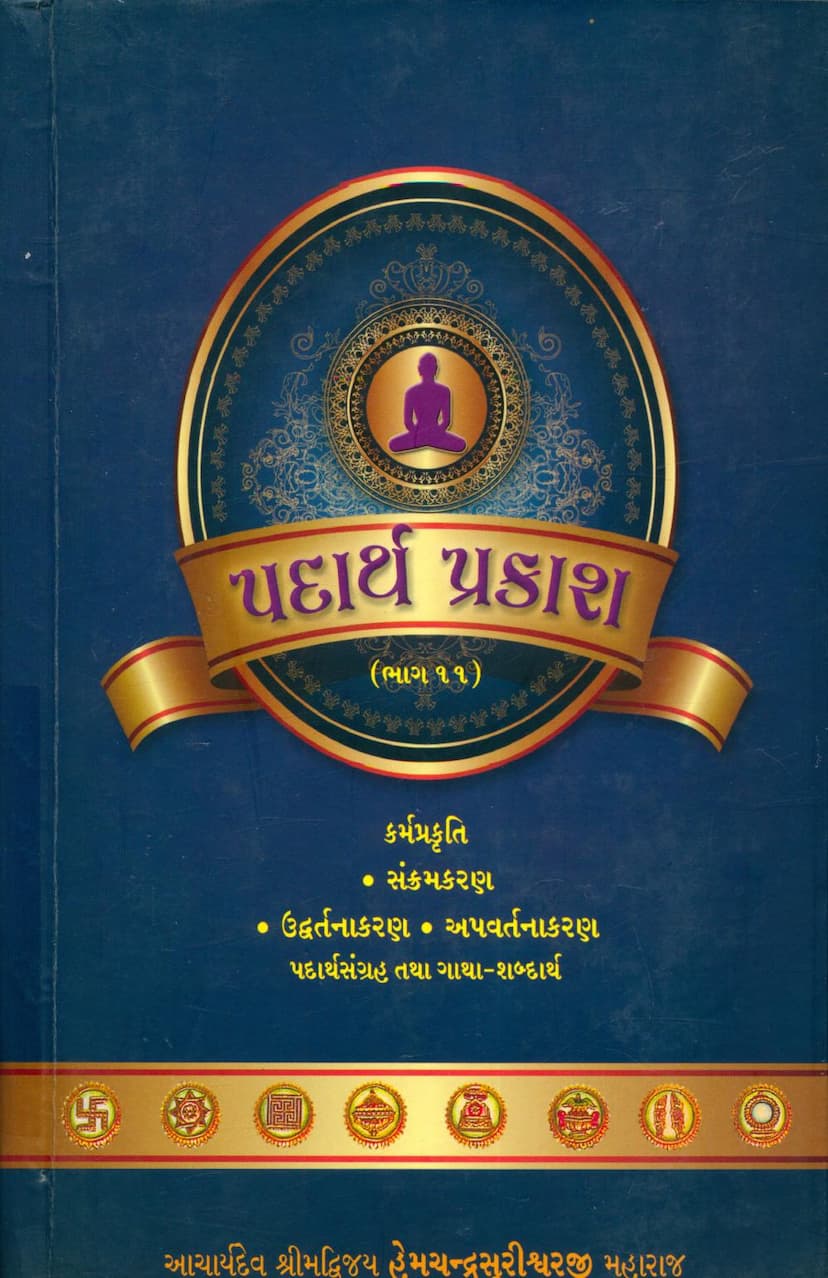Padarth Prakash 11 Karm Prakruti Sankramakaran Udwartakaran Apvartanakaran
Added to library: September 2, 2025

Summary
This document is Padarth Prakash (Part 11): Karm Prakruti - Sankramakaran, Udvartakaran, Apvartanakaran, compiled and edited by Acharyadev Shrimadvijay Hemchandrasurishwarji Maharaj. It is published by Sanghvi Ambalal Ratanchand Jain Dharmik Trust.
Here's a comprehensive summary of the key aspects covered in the text:
Core Subject:
The book delves deeply into specific mechanisms of Karmic transformation within Jain philosophy, focusing on three key processes related to Karmas (actions/deeds) that have already bonded to the soul:
- Sankramakaran (संक्रमकरण): This refers to the transfer of karmic particles (daliya) from one type of Karma to another that is currently being bound. It's about changing the nature or type of karma being experienced.
- Udvartakaran (उद्वर्त्तनकरण): This involves increasing the duration (sthiti) or intensity (rasa) of existing karmas. It's about prolonging or intensifying the experience of karma.
- Apvartanakaran (अपवर्त्तनकरण): This involves decreasing the duration (sthiti) or intensity (rasa) of existing karmas. It's about shortening or diminishing the experience of karma.
Author and Purpose:
- Acharyadev Shrimadvijay Hemchandrasurishwarji Maharaj is the compiler and editor. The text is presented as a compilation of knowledge received from his revered Guru, Acharyadev Shrimadvijay Premsurishwarji Maharaj, who was an expert in Karma literature.
- The purpose of the "Padarth Prakash" series, and this volume specifically, is to make the intricate knowledge of Jain Karma philosophy accessible and understandable to a wider audience. The author emphasizes making complex concepts clear through detailed explanations, tables, and illustrations.
Structure and Content:
The book systematically breaks down these karmic processes:
Part 1: Karmaprakriti Sankramakaran (Sankramakaran)
- Definition: Sankramakaran is explained as transferring karmic particles of an unbound karma into a karma that is currently being bound, making it manifest as that bound karma. Alternatively, it's the mutual transformation of particles of bound karmas into each other.
- Types of Sankram: It is divided into four main types:
- Prakriti Sankram (प्रकृतिसंक्रम): Transfer of karmic nature.
- Sthiti Sankram (स्थितिसंक्रम): Transfer of karmic duration.
- Rasa Sankram (रससंक्रम): Transfer of karmic intensity/flavor.
- Pradesh Sankram (प्रदेशसंक्रम): Transfer of karmic quantity/volume.
- Detailed Analysis: Each type of Sankram is further analyzed with:
- Definitions and characteristics.
- Various classifications (bhed).
- Rules and exceptions (niyam, apvad).
- Progression through the stages of spiritual development (gunsthan).
- Detailed discussions on specific karmas like Mohaniya (delusion karma), Name karma, etc., including their specific sankram locations and rules.
- The concept of "Sadi" (beginning with a cause) and "Anadi" (beginningless) in relation to sankram.
- Tables and diagrams illustrating these concepts.
Part 2: Karmaprakriti Udvartanakaran and Apvartanakaran
- Definitions: Udvartakaran (increasing duration/intensity) and Apvartanakaran (decreasing duration/intensity) are clearly defined.
- Types: Both are further categorized into:
- Sthiti Udvartana/Apvartana: Related to the duration of karma.
- Rasa Udvartana/Apvartana: Related to the intensity/flavor of karma.
- Detailed Analysis: Each type is explained in detail:
- Nirvighat (निर्वाघात): Occurring without hindrance, where new karma's state is similar to or less than the existing karma's state.
- Vighat (व्याघात): Occurring with hindrance, where new karma's state is greater than the existing karma's state.
- The text provides intricate details on how these processes occur, including the concepts of abadha (period of non-manifestation of karma), bandhavalika (period of karmic binding), udayavalika (period of karmic manifestation), and the transfer of karmic particles at different stages.
- Detailed discussions on the "Alp Bahutva" (relative quantity/degree) and the "Swamitva" (who performs these actions) are presented.
- Illustrative diagrams for Nirvighat Sthiti Udvartana and Vighat Sthiti Udvartana are included.
Key Jain Philosophical Concepts Covered:
- Karmas: The text assumes a foundational understanding of the eight types of karmas and their further classifications.
- Gunstan (Stages of Spiritual Progress): The influence of different gunsthans on the occurrence and nature of sankram, udvartana, and apvartana is a recurring theme.
- Vicharya (Thoughts/Intentions): The text indirectly highlights the role of intentions and spiritual states (subha bhava - auspicious, ashubha bhava - inauspicious) in influencing karmic transformations, as mentioned in the introductory section on "High Risk, High Reward."
- Udaya and Satta: The concepts of karma being in manifestation (udaya) and in the soul's possession (satta) are implicitly discussed when explaining how karmas are transferred or modified.
Presentation Style:
- The book aims for clarity and comprehensiveness.
- It uses technical Jain terminology extensively, explaining them through detailed prose.
- The inclusion of tables, diagrams, and the explanation of complex verses (gathas) make the subject matter more digestible.
- The text references original Jain scriptures and commentaries, highlighting the lineage of this knowledge.
Overall Significance:
"Padarth Prakash Part 11" is a significant scholarly work for those seeking a deep understanding of the mechanics of karmic transmigration and modification in Jainism. It provides a detailed, analytical, and systematic explanation of concepts like Sankram, Udvartana, and Apvartana, which are crucial for understanding the soul's journey and the principles of liberation in Jainism. The compilation by Acharyadev Hemchandrasurishwarji Maharaj ensures a thorough and authentic presentation of these profound teachings.